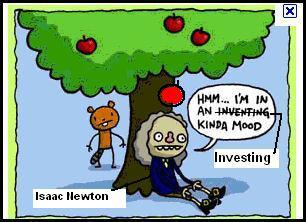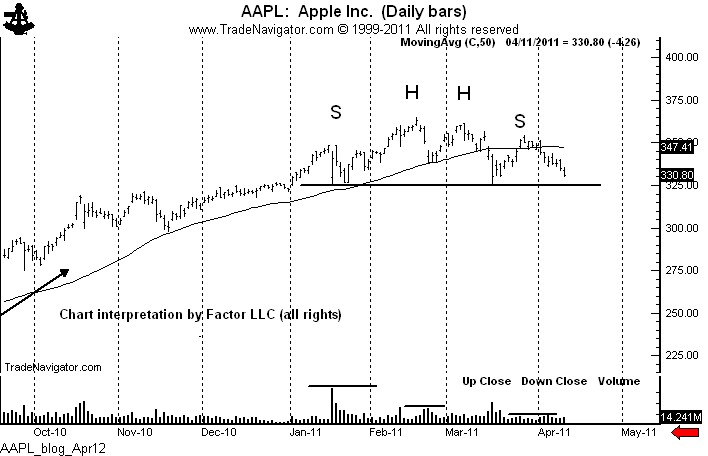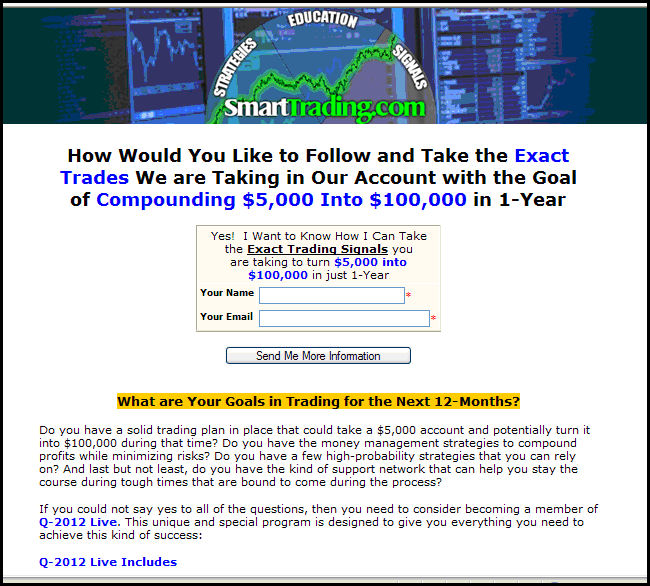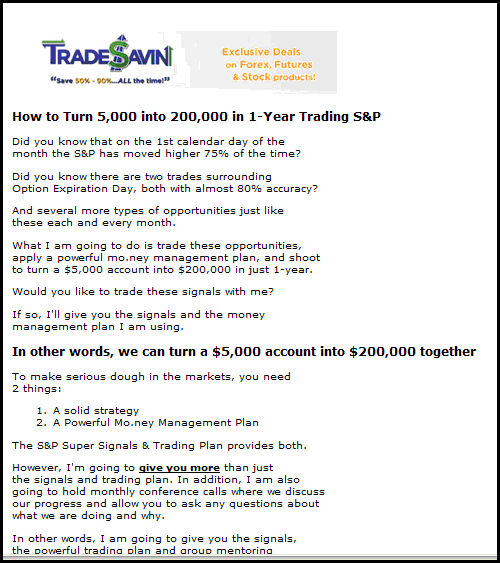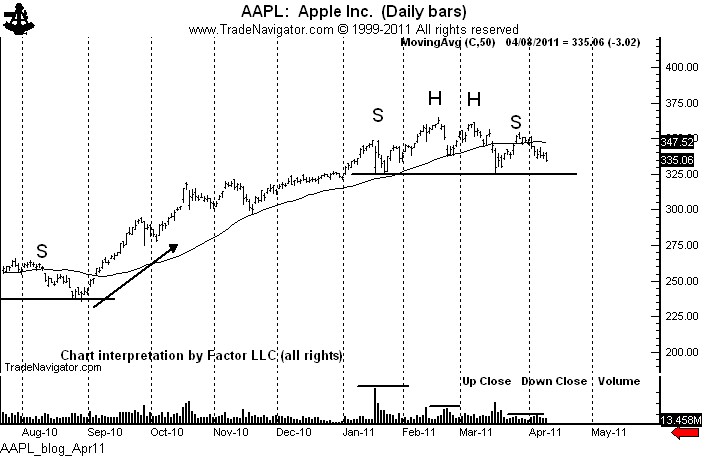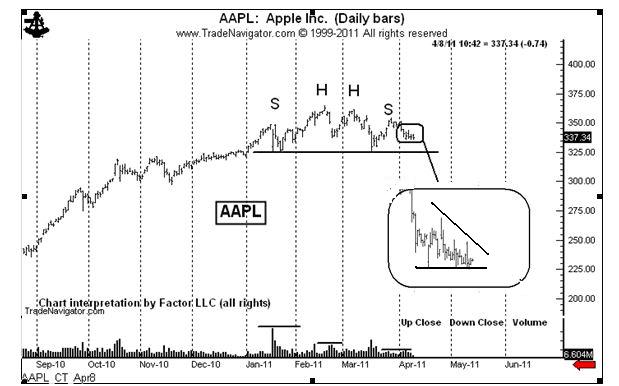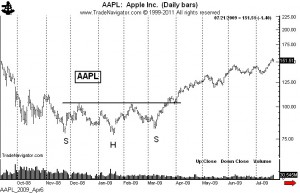Appless Computer – Part 4: 04.12.2011
/by Peter BrandtApple is declining into support.
The poisonous wrath from the Apple Computer “fruit and nut club” continue to come my way. Here are just a couple of excerpts from the “fan” mail I have received because I suggested that AAPL might be topping out.
- “This is nonsense. Never heard of a double head. This is a bullish flag, which means the upside will be equal to its previous rising leg. STOP giving false forecast.” (Emphasis not mine.)
- “Charting[is] so 90…Hello High Freq Trading.”
I do not find these comments offensive or even irritating. I only bring them up because of the humor involved.
“Never heard of a double head.” OK, start with Edwards and Magee, 5th edition, pages 68, 69 and 76 for starters. A double head is not my invention.
“Charting [is] so 90s.” Well, with this in mind let me comment on the chart of AAPL.
The decline on Monday (the 10th down day in 11 days — not exactly a show of strength) has brought prices closer to the critical neckline of the 3-month H&S top. It is show time! The market is NOT oversold, yet I must emphasize that AAPL has NOT completed a top and until it does the trend must be viewed as being UP, not down. The neckline at around 224.50 (+/- 2) will be a magnet for prices.
A decisive close below 320.50 will be the kiss of death for AAPL, and will set up a target of 280 to 285. But if the market can hold above 320, turn back up, spend a full day above the neckline and then advance over 342, a major chart buy signal will set up. Until then I assume that the H&S top will become a reality.
I am short. I have moved stops to 335.81 and 340.27. My risk is presently about 38 basis points. I plan to cover some shorts today if the market opens lower and holds. I would then put the shorts back on if a rally develops. But, if the market opens lower and cannot fill the subsequent gap in the days ahead, my advice to Isaac Newton is… “Duck!”
BTW, there is an upside gap on the chart at 323.48 from Dec. 31. The market may be attempting to fill this gap. Or, the market may gap below the neckline and form an “area island top”….which, of course, like the double head, is also a chart formation I am just making up.
Fraudulent forex…another view: 04.11.2011
/by Peter BrandtWill the fraud ever end?
The fraudulent side of forex trading was revealed in recent weeks in just some of the following blogs and articles:
- Inside the Currency Broiler Rooms, Joshua Brown, The Reformed Broker, April 9.
- Pitfalls of the Currency Casino, Andrew Bary, Barron’s, April 9.
- Foreign currency trading is easy – an easy way to lose money, Nathaniel Popper, Los Angeles Times, April 3.
Hurray for honesty! In my recent book, Diary of a Professional Commodity Trader, this is what I had to say about some retail forex firms:
“Forex dealers who rip off their speculative clients know who they are. I know you are. I am not naming names, although I could. You are abusing small speculators. Shame on you! Stop it! (pg. 136)
I give the above cited blog postings and articles credit for something I should have done – and that is naming names. Joshua, Andrew and Nathaniel, I give you honor.
I’ve been holding onto two other examples of outright fraud that I have intended to write about in this blog. The time is right! One of the examples deals with forex, the other with S&P trading. Both are examples of unscrupulous firms offering novice retail customers enticing trading systems that will never fulfill their promises.
SmartTrading.com
The first one, from a firm calling itself SmartTrading.com, offers a 20-fold return in the first year of trading in forex and S&Ps. Here is a copy of SmartTrading.com’s email promotion.
We longtime traders have really missed the boat! While we have worked hard to make 20% or 30% or even 50% rates-of-return (even having some losing years along the way), we are missing out on the Mission Million Money Management course that is offering 2,000% returns.
TradeSavin
Do you think that a 20-fold annual trading return from SmartTrading is excellent? It’s peanuts compared to what TradeSavin is offering aspiring novice traders. TradeSavin will take our hands and walk us through the tricks of a 40-fold annual return in the S&P market. Imagine that – we can turn $5,000 into $200,000 in just the first year.
It is important for everyone to understand the significance of such a powerful rate-of-return. At this advertised performance rate, by the end of the third year I could be #41 on the world’s wealthiest persons’ list. And just one year later I would be 10 times wealthier than the Carlos Slim family, presently ranked number one.
Of course this does count for the taxes I would need to pay the IRS. But I am generous. By the end of fifth year I would have enough money to pay off the entire national debt. By the end of year 8 or 9, I would be the sole owner of the world’s currency supply. Talk about cornering a market!!!!! This would be the ultimate LONG position.
I challenge the folks at SmartTrading and TradeSavin to reveal IRS tax forms 6781 showing that they have produced the results they so generously offer the public with at least $5,000 of their own mooney for at least two straight years .
In my opinion, these sham operators don’t belong on the world’s wealthiest list – they belong in jail!
###
AAPL Part 3, It’s All About Risk: 04.11.2011
/by Peter BrandtIt has nothing to do with Apple as a company!
This is my third blog posting about Apple Computer in the past week. The first post suggested strongly a possible top in AAPL. The second post detailed a three-part shorting strategy for AAPL. I executed the first two parts of that shorting strategy last week.
I have received hate email for even suggesting that Apple’s stock is subject to a sizable correction. It has been as if I touched the third rail. People have pointed out to me that no bearish analysis should even be considered. I have heard all about the pending changes in accounting procedures for the iPhone…about low forward P/E ratios…about the sales potential in China and Asia…etc.
To my critics I would just say this: “Get a life…I mean no personal insult…I could care less if AAPL goes up or down in price.”
When I see a great signal set up on a chart, I could care less what company it is or what its fundamentals are. In fact, I could care less if I will be right or wrong in the trade — in truth, I assume I will be wrong (I am wrong about 65% of the time). The only important thing to me is the risk/reward profile of the trade.
I shorted 100 shares last week at 338, anticipating a 3-month H&S top. I shorted another 100 shares at 334.38 when a small flag was completed. If the H&S top is completed I will short more AAPL. My protective stops are at 336.19 and 340.51. I am risking 61 basis points on the trade currently. That is 6/10th of 1%, or $600 of each $100,000. I have the potential to make 1400 basis points on the trade, that is a 14% gain on a single trade.
Successful market operations have little to do with correctly picking the direction of a stock — and everything to do with managing the relationship between risk and reward. I will take trades with a 20 to 1 risk/reward relationship any day of the week. I could care less if the trade is in AAPL, or Gold or tapioca futures.
###
AAPL Part 2 – How to build a fabulous risk/reward trade: 04.08.2011
/by Peter BrandtThe Apple is falling — time for the harvest?
I am a trader, not an analyst. Actually, being an analyst is a much harder job. An analyst is pressured to be right. As a trader, I assume I will be wrong 65% of the time. So my job is to find trades with a great risk and reward profile.
Apple Computer is a great real-time, right-now example of how I approach a trade. I believe that AAPL is building a classic H&S top. If this top works, the AAPL chart will be in the textbooks 50 years from now.
As a trader I want to limit my risk to 75 to 100 basis points per trade (e.g., no more than 1% of capital). So, I want to short Apple and risk no more than $1,000 per $100,000 of trading capital. I always think in terms of units of $100,000.
So, I go short today — 100 shares at 338. My risk is to 345, or a risk of $700 per $100,000. First layer is on.
I will short another 100 shares if the market can penetrate this week’s low and complete a small hourly chart flag. So I have an order to sell stop another 100 shares at 334.40. If I am filled I will risk my entire position to above 340 for a total risk of $750 per $100,000 on the 200 shares.
I will short another 100 shares if the H&S top is completed by a move under 322. I will then protect my entire 300 share position to just above 330. If I fill all three layers and get stopped out, I end up with a small profit.
So the bottom line is this: The most I risk by being a bear on Apple is 75 basis points. But what if I am right in my analysis and timing, and remember, a good trade has to be right on both counts? It is not good enough to be right on one component and wrong on the other. The H&S target for Apple is 285. If the market breaks out of the H&S top and does not have a deep retest, then travels to the target, I will have a trade that yields $14,200 or so per $100,000. I am risking 75 basis points to make 1420 basis points. That’s a risk of 3/4 of 1% to make 14%. I will take a trade like this every day. In fact, right or wrong on AAPL, this is exactly the type of trade I love to find. In fact, I should stop being a chart trader if I ingore Apple. As a trader, being right is secondary to making money. Being right is over-rated!
I think this trade has a good shot at doing what I anticipate. The reason is that nobody really thinks Apple can drop. Yet, it has declined nine out of the past 10 trading sessions, the 50 day MA has rolled over and the volume profile of the H&S pattern is absolutely textbook. It has not completed a top yet, but time will tell the story.
The AAPL is swinging in the wind from the branch. I will stand below the tree with a bushel basket.
###
The Apple (AAPL) is falling from the tree – Chart Review: 04.06.2011
/by Peter BrandtIs the Apple about to take a fall from the tree?
Summary
There are chart patterns…then there are textbook chart patterns. Presently Apple Computer (AAPL) is forming a head and shoulders top that could go into the textbooks as an example of classical charting principles.
The daily chart of AAPL exhibits a near-perfect example of the H&S pattern. Several aspects of this chart are worthy of note.
- The pattern actually has a double head. This adds to the bearish potential of the pattern.
- The decline since the March 28 high (the high of the right shoulder) has taken place against the backdrop of new highs in most of the major stock indexes.
- The neckline is nearly flat. Horizontal necklines add reliability to a H&S pattern.
- The volume profile is straight out the Edwards and Mage (and Schabacker) textbooks. Note the heavy volume on the left shoulder, slightly less volume throughout the head, and finally light volume in the right shoulder, particularly during the mid- to-late March rally. This volume profile is a classic example of price distribution – shares moving from stong hands to weak hands.
It is important to understand that this pattern has NOT yet been completed. This is a chance this pattern could fail to materialize. Chart patterns are most useful as trading tools, not for making price forecasts. Short positions established at current levels could be protected using the March 28 high at 354.32. A decisive close above the existing right shoulder high would largely negate this H&S interpretation.
A close below 320 would complete the H&S top. Is must be remembered that the H&S pattern indicates a change in the primary trend and can carry prices far beyond the measured move. I have included a chart of the H&S bottom for Apple computer completed in 2009 prior to this incredible bull trend.
My game plan is to wait for a breakout and then risk about 150 basis points on a short position, or one and one-half percent of trading capital. The Apple may stay on the tree and ripe some more, but a strong wind could end this apple’s growing season.
Summary
There are chart patterns…then there are textbook chart patterns. Presently Apple Computer (AAPL) is forming a head and shoulders top that could go into the textbooks as an example of classical charting principles.
The daily chart of AAPL exhibits a near-perfect example of the H&S pattern. Several aspects of this chart are worthy of note.
- The pattern actually has a double head. This adds to the bearish potential of the pattern.
- The decline since the March 28 high (the high of the right shoulder) has taken place against the backdrop of new highs in most of the major stock indexes.
- The neckline is nearly flat. Horizontal necklines add reliability to a H&S pattern.
- The volume profile is straight out the Edwards and Mage (and Schabacker) textbooks. Note the heavy volume on the left shoulder, slightly less volume throughout the head, and finally light volume in the right shoulder, particularly during the mid- to-late March rally. This volume profile is a classic example of price distribution – shares moving from stong hands to weak hands.
It is important to understand that this pattern has NOT yet been completed. This is a chance this pattern could fail to materialize. Chart patterns are most useful as trading tools, not for making price forecasts. Short positions established at current levels could be protected using the March 28 high at 354.32. A decisive close above the existing right shoulder high would largely negate this H&S interpretation.
A close below 320 would complete the H&S top. Is must be remembered that the H&S pattern indicates a change in the primary trend and can carry prices far beyond the measured move. I have included a chart of the H&S bottom for Apple computer completed in 2009 prior to this incredible bull trend.
My game plan is to wait for a breakout and then risk about 150 basis points on a short position, or one and one-half percent of trading capital. The Apple may stay on the tree and ripe some more, but a strong wind could end this apple’s growing season.
###

